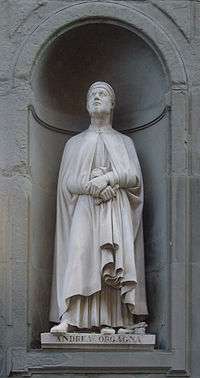Orcagna

Statue of Andrea Orcagna in the Uffizi outside gallery in Florence carved by Niccolò Bazzanti at Pietro Bazzanti e Figlio Art Gallery, Forence
Andrea di Cione di Arcangelo (c. 1308 – August 25, 1368), better known as Orcagna, was an Italian painter, sculptor, and architect active in Florence.
Early life
A student of Andrea Pisano as well as Giotto di Bondone, his younger brothers Jacopo di Cione and Nardo di Cione were also artists. The di Cione (pronounced dee choh’ nay) brothers often worked collaboratively.
Works
Orcagna's works include:
- "Altarpiece of the Redeemer" (1354–57) in the Strozzi di Mantova Chapel at Santa Maria Novella, Florence
- The tabernacle in Orsanmichele (finished 1359) which was regarded as "the most perfect work of its kind in Italian Gothic".[1]
- His fresco The Triumph of Death inspired Franz Liszt's masterwork Totentanz.
The mosaic decoration and the rose window of the cathedral of Orvieto is attributed to Orcagna, who had become Master of the Works in 1359.
Pupil
Among Orcagna's pupils or legacy were:
- Nello di Vanni, a Pisan painter of the 14th century, who also worked for the Campo Santo. Nello di Vanni is conjectured to be identical with Bernardo Nello or Giovanni Falcone.[2]
- Tommaso del Mazza, called Tomasso di Marco by Giorgio Vasari.[3]
- Jacopo di Cione -brother of Andrea and mainly sculptor and architect[4]
- Mariotto Orcagna -grandson of Andrea, painter[5]
References
- ↑ "Orcagna". Catholic Encyclopedia.
- ↑ Bryan, Michael (1889). Walter Armstrong & Robert Edmund Graves, ed. Dictionary of Painters and Engravers, Biographical and Critical (Volume II L-Z). York St. #4, Covent Garden, London; Original from Fogg Library, Digitized May 18, 2007: George Bell and Sons. p. 586.
- ↑ Le vite de' più eccellenti pittori, scultori ed architettori, Volume 1, by Giorgio Vasari, Editor G. C. Sansoni, (1906); page 609.
- ↑ Vasari, page 610.
- ↑ Vasari, page 610.
| Wikimedia Commons has media related to Andrea Orcagna. |
This article is issued from Wikipedia - version of the 10/23/2016. The text is available under the Creative Commons Attribution/Share Alike but additional terms may apply for the media files.